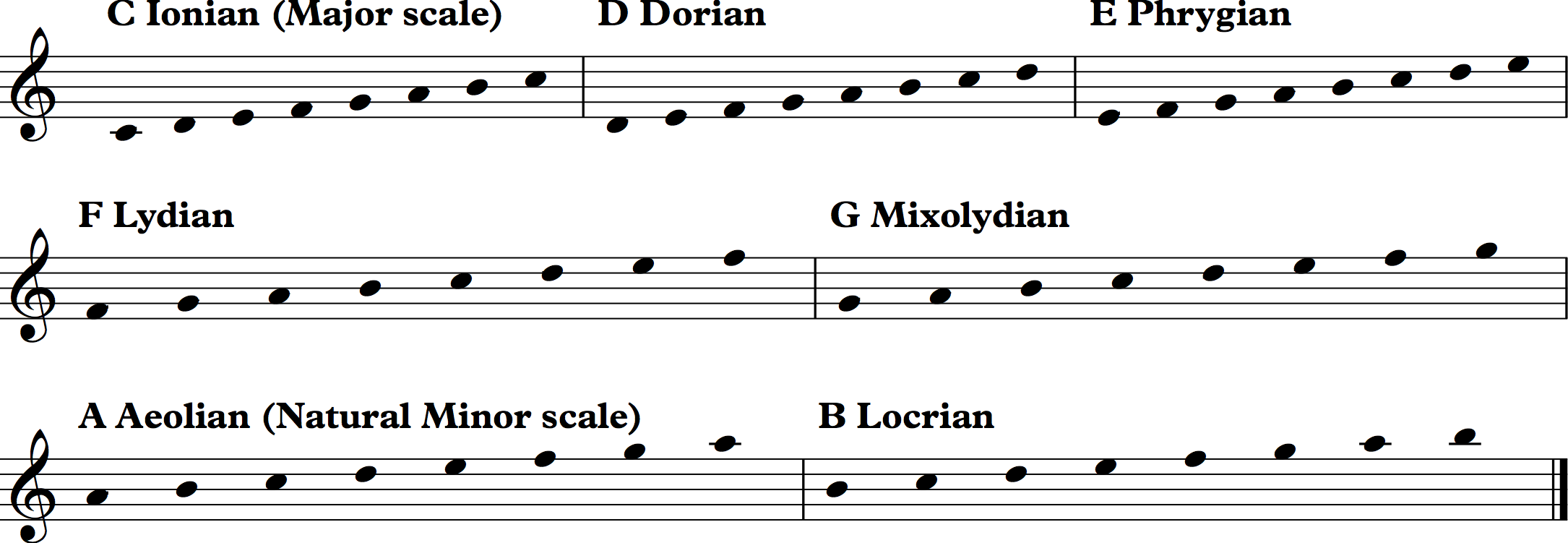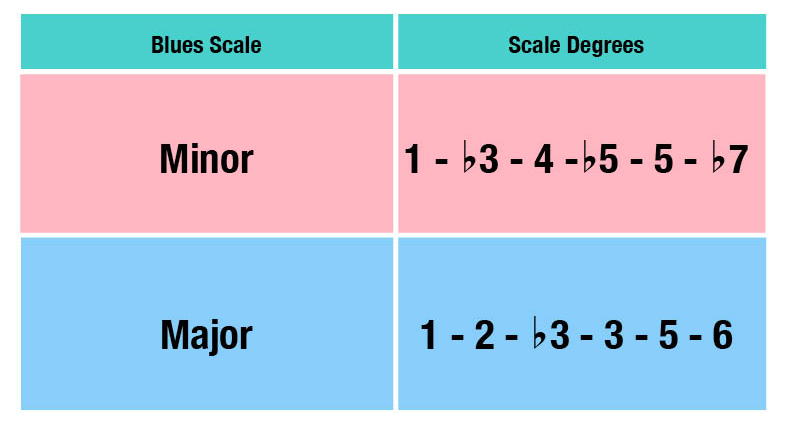Sumi Vora
AP Music Theory 🎶
72 resourcesSee Units
Western Musical Modes
So far, we have been writing in Major and minor mode. However, there are lots of other musical modes that we could write in. Suppose we keep our key signature in C Major, but we build a scale starting on D, so we have D-E-F-G-A-B-C-D. Now, the pattern of whole and half steps looks something like W-H-W-W-W-H-W. If we write music in this mode where we treat D like the tonic, we will get very different sounding chord progressions than we are used to in D Major. The scale built on the supertonic of a Major scale is called Dorian mode. If we build a Dorian scale on D, we call it “D Dorian.”
Modal music is a type of music that is based on a specific mode, rather than a major or minor key. This means that the melody, harmony, and chords are all built around the specific pattern of whole and half steps of the chosen mode. Modal music can have a unique and distinct sound, and it can also create a specific emotional or cultural feel.
Just like minor and Major modes have different sounds and moods, all of the other musical modes also have distinct qualities.
The seven traditional modes in Western music include:
- Ionian: This is the major scale, which consists of a specific pattern of whole and half steps (W-W-H-W-W-W-H). It has a bright and happy sound.
- Dorian: This mode is similar to the natural minor scale, but with a raised sixth degree. It has a minor quality with a slight hint of major sound.
- Phrygian: This mode is similar to the natural minor scale, but with a lowered second degree. It has a distinct Spanish or Middle Eastern sound.
- Lydian: This mode is similar to the major scale, but with a raised fourth degree. It has a bright and dreamy sound.
- Mixolydian: This mode is similar to the major scale, but with a lowered seventh degree. It has a dominant quality, often used in blues and rock music.
- Aeolian: This is the natural minor scale, which consists of a specific pattern of whole and half steps (W-H-W-W-H-W-W). It has a sad and serious sound.
- Locrian: This mode is similar to the natural minor scale, but with a lowered second and fifth degrees. It has a tense and dissonant sound.
Dorian modes are built by beginning on the supertonic (2nd scale degree) of a Major scale. Similarly, Phrygian modes are built starting on the mediant of the Major scale, Lydian modes are built starting on the subdominant of a Major scale, and so on.
Modes are always referred to based on the beginning note of their scale. So, even though we might build a Lydian mode using the key signature of C Major, it is F Lydian, because the actual scale in Lydian mode starts on an F.

Image via Flypaper
Besides the Ionian mode and the Aeolian mode, which are just the Major and natural minor diatonic scales, the two other commonly used modes in music are the Dorian and Mixolydian. Just like the Ionian and Aeolian modes are considered relative keys, because the Aeolian is the relative minor of the Major scale, the Dorian is considered a relative to the Mixolydian, which has a dominant tonality. So, if we are spending a lot of time in dominant harmonies in some section of a piece, we might see some Dorian tonality to complement the Mixolydian tonality.
Note that this is different from tonicization or modulation, because we are not adding accidentals to turn the dominant tone into a temporary tonic. Instead, the Mixolydian and Dorian tonalities have very different, but complementary, sounds to the Major and minor scales that we usually study in music.
If you want to get a feel for what the musical modes sound like, listen to this collection of Gregorian Chants. The Gregorian modes are Dorian, Phrygian, Lydian, and Mixolydian, so you will hear all of these in the pieces.
It's important to note that modes are not only used in ancient or classical music, but also in other genres such as jazz, folk, and pop music. For example, in jazz, modes are often used as the basis for improvisation and in pop music, they can be used to create a specific mood or atmosphere.
History of Western Musical Modes
The concept of musical modes has a long and complex history in Western music. The earliest known system of modes was developed in ancient Greece and was used in the music of the time. This system consisted of seven modes, each with its own distinctive character and associated with a specific range of emotions. The modes were named Dorian, Phrygian, Lydian, Mixolydian, Aeolian, Ionian, and Locrian.
During the Middle Ages, the concept of modes was further developed in the music of the Christian Church. Monks and other church musicians used the modes to create a sense of modality in their music, which was meant to reflect the religious texts they were singing. This system of modes was based on the eight church modes, which were named Dorian, Phrygian, Lydian, Mixolydian, Aeolian, Ionian, Hypodorian, and Hypophrygian.
With the emergence of polyphony in the Renaissance period, composers began to experiment with different ways of using the modes. They discovered that by changing the starting note of a mode, they could create a different harmonic effect, which led to the development of the concept of tonality. This system of tonality, which is still in use today, is based on the major and minor keys, which are created by using different combinations of notes from the modes.
In the Baroque period, composers such as Johann Sebastian Bach and Georg Friedrich Handel wrote music that was based on the modes, but they also incorporated elements of tonality into their compositions. This led to a more complex system of modality, which was further developed in the Classical period by composers such as Wolfgang Amadeus Mozart and Ludwig van Beethoven.
With the emergence of romanticism in the 19th century, the modes fell out of use in Western classical music, and the major and minor keys became the norm. However, in the 20th century, composers such as Arnold Schoenberg and Igor Stravinsky experimented with modal composition, leading to a renewed interest in the modes.
Today, the modes are still studied and used in Western classical music, and many composers continue to incorporate elements of modality into their compositions. The modes are also found in the tradition of jazz and in certain forms of popular music, such as the blues and folk music.
Other Musical Modes
In addition to these seven traditional modes, there are other modes that have been used in various forms of music.
Pentatonic scales are musical scales that consist of five notes per octave. They are used in a variety of musical styles around the world. Quite a bit of traditional Asian music is pentatonic, and as such, the pentatonic scale is often associated with Asian music.
However, pentatonic scales have been used in music for thousands of years and can be found in a wide range of musical traditions around the world. In the 20th century, pentatonic scales became a key element in the development of blues, jazz, and rock music. They are widely used in these genres, as well as in many other contemporary styles of music.
There are two types of pentatonic scales: the minor pentatonic scale and the major pentatonic scale. The minor pentatonic scale is made up of the 1st, 3rd, 4th, 5th, and 7th degrees of a natural minor scale. For example, the A minor pentatonic scale consists of A C D E G. The major pentatonic scale is made up of the 1st, 2nd, 3rd, 5th, and 6th degrees of a major scale. For example, the C major pentatonic scale consists of D E F# A B.
The blues scale is a variation of the pentatonic scale, which is a five-note scale that is often used in traditional music from Africa and Asia. The blues scale consists of the following notes: root, minor third, fourth, fifth, and minor seventh. This scale is often used to create a bluesy, "soulful" sound in music.
The use of the blues scale can be traced back to African American music of the 19th century, specifically in the Mississippi Delta region. The scale was used by early blues musicians, such as W.C. Handy and Bessie Smith, to create a sense of sadness and longing in their music. As the blues genre evolved, the scale was also incorporated into jazz and rock music, becoming a staple in these styles.
The blues scale incorporates a "blue note" into major or minor pentatonic scales. This note is a flattened or "bent" fifth scale degree. This note gives the scale its characteristic "blue" sound and adds a sense of dissonance and tension to the music.

Image via Guitar.com
Indian classical music uses a system of scales called ragas, which are similar to the Western concept of modes. A raga is a set of melodic rules for improvisation and composition. Each raga has a specific set of notes that are used, as well as guidelines for how those notes should be used in a melody.
For example, the raga Bhairav uses the notes C, C#, D, D#, E, F, G, A, Bb, and B, and emphasizes the use of certain notes at specific times of the day or in certain seasons. The raga Malkauns, on the other hand, uses the notes C, C#, D, D#, F, G, and A, and is typically associated with a more meditative or contemplative mood.
In addition to these modes, composers have also created other modes such as the whole tone scale, octatonic scale, and hexatonic scale. These scales have unique intervals and sonorities and have been used extensively in the 20th century in compositions by Debussy, Ravel and Stravinsky.
Browse Study Guides By Unit
🎵Unit 1 – Music Fundamentals I (Pitch, Major Scales and Key Signatures, Rhythm, Meter, and Expressive Elements)
🎶Unit 2 – Music Fundamentals II (Minor Scales and Key Signatures, Melody, Timbre, and Texture)
🎻Unit 3 – Music Fundamentals III (Triads and Seventh Chords)
🎹Unit 4 – Harmony and Voice Leading I (Chord Function, Cadence, and Phrase)
🎸Unit 5: Harmony and Voice Leading II: Chord Progressions and Predominant Function
🎺Unit 6 – Harmony and Voice Leading III (Embellishments, Motives, and Melodic Devices)
🎤Unit 7 – Harmony and Voice Leading IV (Secondary Function)
🎷Unit 8 – Modes & Form
🧐Exam Skills
📚Study Tools

Fiveable
Resources
© 2025 Fiveable Inc. All rights reserved.